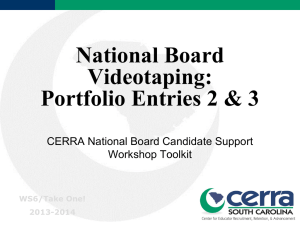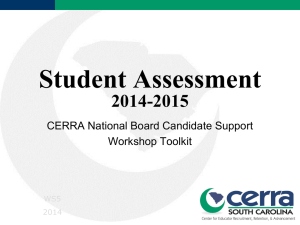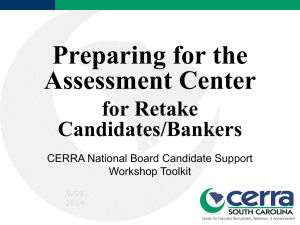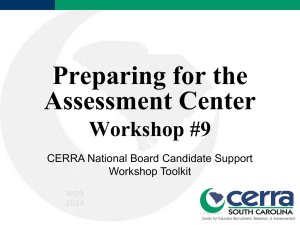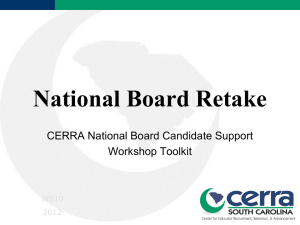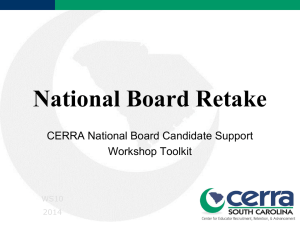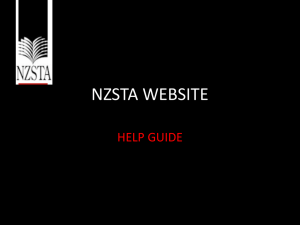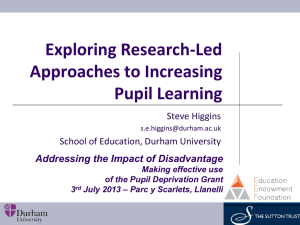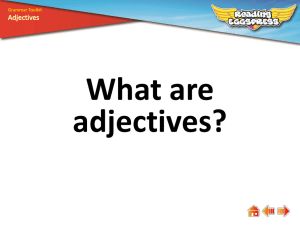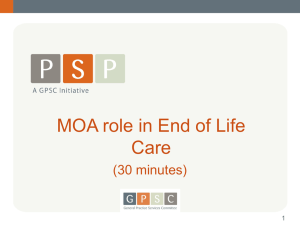WS4 Ppnt.Writing
advertisement
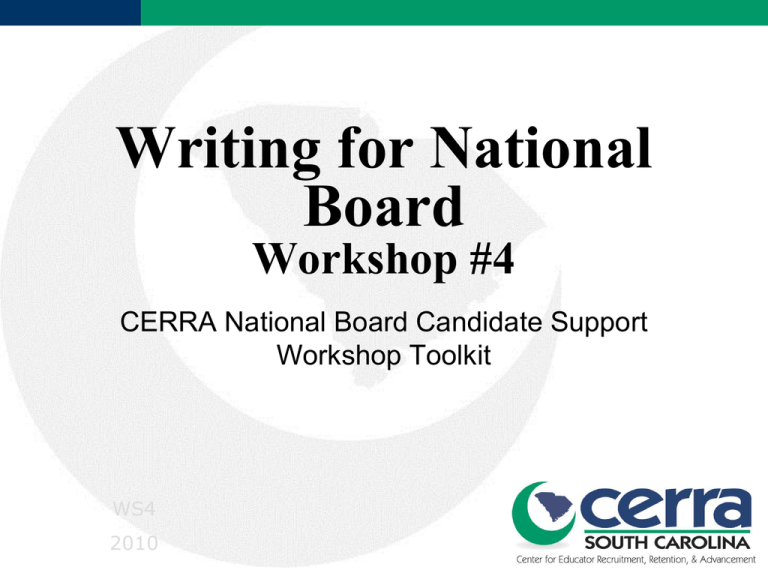
Writing for National Board Workshop #4 CERRA National Board Candidate Support Workshop Toolkit WS4 2010 Essential Questions • How will I know what to write? • What types of writing are used in the National Board process? • How can I think more purposely & strategically about my work and my students’ work so I can write effectively? • How can I make use of the stages/steps of writing? CERRA National Board Toolkit 2 General Portfolio Instructions • Writing about Teaching Three Types of Writing for NB --Descriptive – What happened? --Analytical – How, why, in what way? --Reflective – How would you handle the situation in the future? CERRA National Board Toolkit 3 Key Points from the Instructions • Clarify how everything is purposeful. Answer key questions and make key points. • Ask why and how after everything to be more analytical and reflective. • Say it and show it. NB is evidence-based. • Provide responses appropriate for your content, grade level, and portfolio questions. • Review your writing for clarity. CERRA National Board Toolkit 4 Descriptive Writing • Tell what has happened in your classroom. In this sense, descriptive writing overlaps with narrative writing since it portrays a sequence or procedure or process. • Description “sets the scene” of the work. • It is logically ordered and detailed. • Prompts use verbs such as “state,” “list,” “describe,” or start with “what” or “which.” CERRA National Board Toolkit 5 Descriptive Writing Continued Your response should • contain accurate and precise enumeration and/or explanation of critical features. • provide clear and logical ordering of the elements or features of the event, person, concept, or strategy described. • include all features or elements that an outsider (assessor) would need to be able to see as you see. Taken from General Portfolio Instructions CERRA National Board Toolkit 6 Analytical Writing • • • • • • provides reasons, motives and interpretation. is grounded in evidence (materials you submit). shows your thought process. answers “how,” “why,” or “in what way(s).” portrays insight when you are asked to identify a particularly successful moment in a sample of teaching and to tell why you regard it as successful. includes a rationale, logic, examination of the parts that create the whole. CERRA National Board Toolkit 7 Reflective Writing • includes your thought process (meditation and contemplation) after you teach. • demonstrates how you make decisions. • shows how you use what you learned from teaching experiences to inform and improve future practice. • portrays your self-analysis and retrospective consideration. CERRA National Board Toolkit 8 Analytical and Reflective Writing • • • • These writings overlap but are not identical. When you are asked to analyze or reflect, be certain that your response meets these criteria: The subject of the analysis is available to the reader (e.g., the student work samples, the video recording). The focus of your writing is not on what (which is descriptive) but rather on why (which is both analytical and reflective). Taken from General Portfolio Instructions CERRA National Board Toolkit 9 Analytical and Reflective Writing Continued You need to provide the following: • your interpretations of what happened during the lesson and its results • your conclusions about what should come next • specific evidence and/or examples that support your analysis and conclusions, making your points clearly to the assessors Taken from General Portfolio Instructions CERRA National Board Toolkit 10 Unpacking the Prompts • All entries are based on the same logical, but not linear path. • Begin with descriptions of the class, students featured, the unit being taught. • Move through planning and teaching stages to analyze the choices you and your students make. • End with reflection on the content, the students, and yourself. CERRA National Board Toolkit 11 Part One: Instructional Context • This is a discussion of what you knew BEFORE you planned and taught your lesson/unit (and on which you based all the subsequent instructional choices). • Curriculum • Students • Setting • Instructional context should be different for each entry. CERRA National Board Toolkit 12 KOS Dimension 1 Making knowledge accessible to all learners • • • • • • • Understanding of student background experiences and knowledge Previous school experience Interests (in and out of school) Special skills Learning styles Challenges Attitude about school CERRA National Board Toolkit 13 KOS Dimension 2 Knowledge of how students of this age develop and learn • Intellectual/Cognitive stages (What is appropriate for these students to learn?) • Physical (What are typical growth patterns, need for movement, abilities of these students?) • Social (How do children at this age interact, establish trust with adults, deal with conflicts in relationships?) • Emotional (How do children at this age deal with frustration, anger etc.? What do they need to feel safe and secure?) CERRA National Board Toolkit 14 KOS Dimension 3 Respect and consideration for individual cultural, linguistic, and family differences • • • • • • What skills and personality traits make this student unique? Where does this child live? Who cares for this child? What is this child’s ethnicity? What characteristics of this ethnic group must I know in order to teach this child and relate with his/her family? What language(s) does this child speak? What language is spoken in the home? What are the family’s expectations? What attitudes about school are present in the home? CERRA National Board Toolkit 15 KOS Dimension 4 Knowledge of students’ self-concept, motivation, relationship with peers/adults • • • • • • Is this child a confident learner? Does he/she approach tasks eagerly? Is this child happy to be at school? Is he/she proud of his/her accomplishments? Does this student get along well with other children? Is he/she well liked? Does this child develop trusting relationships with adults? Can he/she ask for and accept help from adults? CERRA National Board Toolkit 16 Part Two: Planning for Instruction • Describe the planning process you used when designing the highlighted unit of instruction. • Describe methods, materials, and activities you hope to include. • Justify each choice based on the information you presented in the instructional context. Key Words: • • “For these students at this time” “…that influenced my…(planning, choice of materials, etc.)…for THIS instruction… CERRA National Board Toolkit 17 Part Two: Planning for Instruction • The assessor should feel that your choices are logical and academically grounded. • The assessor should be convinced that you know • your students well. • what content to present. • the best way to present the content. CERRA National Board Toolkit 18 Part Three: Analysis of Instruction Student Work, Videotape, Assessment Analyze your teaching by responding: • How did your activities further student learning (or not)? • How did you probe students’ thinking? • How did you address misunderstandings? • Was what you actually did different from what you planned to do? Explain. • How well did the students understand the lesson? How do you know? CERRA National Board Toolkit 19 Part Three: Analysis of Instruction Student Work, Videotape, Assessment You will be asked to analyze the following: • student work • evidence of student learning • your practice as shown on videotape • one or more particular teaching strategies you chose to use. CERRA National Board Toolkit 20 Part Four: Reflection • What did you learn about the students, the curriculum, yourself? • How will that new knowledge be used? • What parts of your instruction worked well? • What evidence supports your conclusions? • What parts of your instruction could have been done differently? • How might you change the lesson in the future? • What results would you expect? CERRA National Board Toolkit 21 Your Teaching Is Portrayed… • • • • Clearly Consistently Convincingly Your portfolio entries lead the assessor through your decision-making processes so carefully that he or she is not surprised by a decision, recommendation, or conclusion you make about your students, your curriculum, or yourself. CERRA National Board Toolkit 22 Understanding the Questions • Questions are written in italics followed by clarifying questions. • You must pay attention to and answer BOTH! • The non-italicized portion will be very helpful to you as you seek to include analysis in your portfolio. • You might want to embed in your responses key words from the questions. CERRA National Board Toolkit 23 A Closer Look: A Prompt from a Portfolio • What are the central features of the three segments selected for the videotape? Explain how the three segments support different aspects of inquiry. From AYA Science 2002-2003 CERRA National Board Toolkit 24 A Closer Look Prompt What Must I Do? What are the central features of the three segments selected for the videotape? DESCRIBE my videotape segments. Explain how the three segments support different aspects of the inquiry process. ANALYZE the three segments and tell HOW they are related to the inquiry process. CERRA National Board Toolkit 25 Unpacking the Prompts: Example Prompt What Must I do? Finding Evidence What characteristics of the selected work samples demonstrate the student’s ability to understand and interpret text? ANALYZE student responses to text. HOW/WHERE is “understanding” demonstrated in the student’s response to the reading passage? What different ways could the text have been interpreted? What does the student’s interpretation indicate about his learning? CERRA National Board Toolkit 26 Stages of Writing • Prewrite—brainstorm, list, outline • Draft—organize notes & ideas into paragraphs • Revise—conference; meditate; paraphrase for clarity, accuracy, thoroughness • Edit—address diction, order, sentence structure, examples given • Polish—check mechanics, grammar, spelling • Publish—submit your revised, edited work. CERRA National Board Toolkit 27 More Information National Board for Professional Teaching Standards® www.cerra.org 1-800-476-2387 CERRA nationalboard@cerra.org virginia @cerra.org Virginia Bartels School District Liaison: CERRA National Board Toolkit www.nbpts.org 1-800-22-TEACH 28
